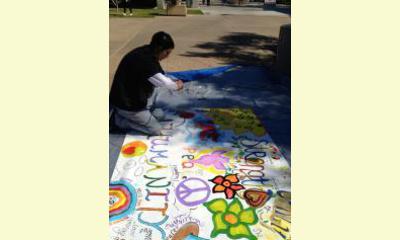|
|
Institutionalizing an Academic Path for Future Peacebuilders (USA)
an article by Katie Zanoni, Stanford Human Rights Education Initiative
This April, San Diego City College (SDCC) led the
effort to institutionalize the field of Peace
Studies within the California Community College
system. On April 20, 2013 the Academic Senate for
California Community Colleges voted in favor of a
resolution to create Peace Studies as a discipline
as recognized in the statewide Minimum
Qualifications Discipline List. This means that
Peace Studies will now be nested within the master
list alongside other mainstream disciplines such
as Math, Biology, and Anthropology thus increasing
the credibility around this field that educates
our future human rights advocates and
peacebuilders.

A student from San Diego City College uses his artistic skills while working on the mural with the Art Miles Mural project
click on photo to enlarge
In 2009, SDCC became the first community college
in California to offer a state-approved Associate
Degree in Peace Studies, and faculty have served
hundreds of students enrolled in the core courses
(Introduction to Peace Studies; Nonviolence and
Conflict Resolution; Environmental Sustainability,
Justice and Ethics; and Field Work in Peace
Studies). Current students in the program plan to
pursue careers in fields such as international
law, human rights advocacy, violence prevention,
and humanitarian aid.
Human rights education is an integral piece of the
curriculum within Peace Studies courses and is one
of the core pillars of the program at SDCC. The
field of Peace Studies can be defined as a field
of inquiry within the social sciences that
examines prevention, de-escalation and resolution
of conflict as well as post-conflict peacebuildng.
Peace Studies considers the root causes of a
conflict through the interdisciplinary approach to
build peace in a nonviolent manner by addressing
human rights violations, establishing just and
equitable societies, and ensuring ecological
sustainability.
San Diego City College offers a model for other
campuses to expand their curriculum to establish
more Associate Degrees in Peace Studies. SHREI
curricular resources will no doubt be vital to
instructors teaching Peace Studies courses in
California, and will help achieve one of the
programís main goals which is to allow students to
think critically about their role in the world and
their possible contributions to a more peaceful
world.
[Note: Thank you to Joanne Tawfilis, the CPNN
reporter for this article.]
|








|
DISCUSSION
Question(s) related to this article:
How do we promote a human rights, peace based education?,
* * * * *
Latest reader comment:
Question: what is the relation between peace and education?
http://cpnn-world.org/new/?p=4780
We teach the science of war on an even and equal basis with the 3Rs and we maintain it with more resources than any other school. Further, we have done this consistently for a couple of thousand years, long before education was institutionalized for all children. And we have never questioned the wisdom of teaching millions of civilians how to kill while never giving the same credence, or any for that matter, to the science of peace, the study of anti-war, of reconciliation. With this inured mindset leaders choose to fund boot camps and officer training colleges and by omission deprive youth of the better choice.
If we can teach war and violence with such commitment to suit the purposes of generals and the arms trade, where are the rest of us who have a greater need for peace and conciliation than anyone anywhere has for the killing fields? Why have civilians not demanded peace education long ago and why don't we have it now?

|
|









